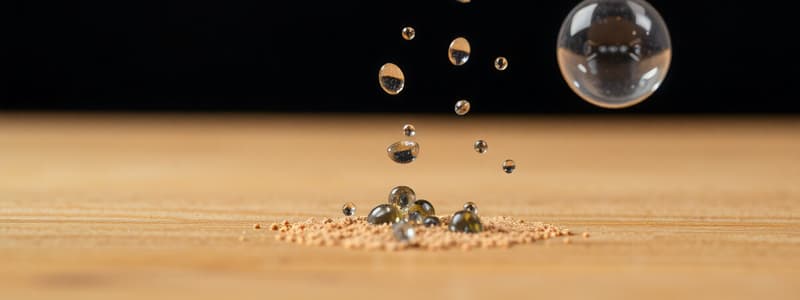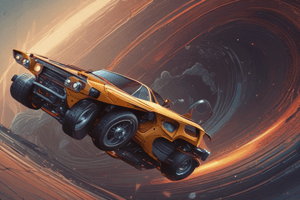Podcast
Questions and Answers
Which of the following scenarios best illustrates a non-contact force?
Which of the following scenarios best illustrates a non-contact force?
- A person pushing a stalled car.
- A box sliding down a ramp.
- A hand writing on a whiteboard.
- An apple falling from a tree. (correct)
A book rests on a table. Which force primarily prevents the book from moving?
A book rests on a table. Which force primarily prevents the book from moving?
- Applied force.
- Sliding friction.
- Static friction. (correct)
- Fluid friction.
In which of the following situations is fluid friction most significant?
In which of the following situations is fluid friction most significant?
- A parachute slowing a skydiver. (correct)
- A hockey puck sliding on ice.
- A car driving on a wet road.
- A train moving along a track.
How does increasing the mass of an object affect the gravitational force it experiences?
How does increasing the mass of an object affect the gravitational force it experiences?
Two objects are moved so their separation distance doubles. How does this affect the gravitational force between them?
Two objects are moved so their separation distance doubles. How does this affect the gravitational force between them?
A box is pushed with a force of 150N, but does not move. What can be concluded about the static friction?
A box is pushed with a force of 150N, but does not move. What can be concluded about the static friction?
An object is sliding across a rough surface at a constant speed. Which of the following statements is most accurate?
An object is sliding across a rough surface at a constant speed. Which of the following statements is most accurate?
A car is traveling down the highway. Which type of friction is primarily acting against its movement?
A car is traveling down the highway. Which type of friction is primarily acting against its movement?
Which of the following is an example of converting sliding friction to static friction to increase safety?
Which of the following is an example of converting sliding friction to static friction to increase safety?
Consider a feather and a hammer dropped simultaneously on the Moon (where there is no air resistance). Which of the following is true?
Consider a feather and a hammer dropped simultaneously on the Moon (where there is no air resistance). Which of the following is true?
Flashcards
Force
Force
A push or pull on an object.
Contact Force
Contact Force
A force that requires direct contact between objects.
Non-Contact Force
Non-Contact Force
A force that acts between objects that are not touching.
Friction
Friction
Signup and view all the flashcards
Static Friction
Static Friction
Signup and view all the flashcards
Sliding Friction
Sliding Friction
Signup and view all the flashcards
Fluid Friction
Fluid Friction
Signup and view all the flashcards
Gravity
Gravity
Signup and view all the flashcards
Mass
Mass
Signup and view all the flashcards
Mass and Gravity
Mass and Gravity
Signup and view all the flashcards
Study Notes
- Forces change the motion of an object
Contact vs Non-Contact Forces
- A force is a push or pull on an object.
- Contact force occurs when one object pushes or pulls another by touching it, examples include pushing a container, pressing on computer keys, and friction.
- Non-Contact Force occurs when one object pushes or pulls another without touching it, examples include magnetic, electrical, and gravity.
Friction
- Friction is a force that resists the motion of two objects that are touching.
- Static friction prevents objects from sliding past each other.
- Sliding friction opposes the motion of objects sliding past each other.
- Fluid friction occurs between a surface and a fluid, like water or air (air resistance).
Gravity and Mass
- Gravity: An attractive force that exists between all objects that have mass
- Mass: Amount of matter in an object
- The more the mass, the more gravitational pull
- The greater the distance, the less gravitational pull
- Weight is the amount of gravitational force exerted on an object, measured in newtons.
- Weight would be less on the moon.
Static Charge
- Static Charge: Unbalanced positive or negative charge on an object.
- Opposite charges attract each other.
- The same charges repel each other.
- The more the charge, the greater the electrical force (attractive or repulsion).
- The more distance, the less electrical force.
Magnets
- Magnet: Object that attracts metal iron.
- Magnetic Pole: A place on a magnet where the force applied is the strongest.
- Opposite poles (charges) attract each other
- The same poles (charges) repel each other
- The further away the magnets are the weaker the magnetic force
- Magnetic strength depends on the size of the magnet.
Studying That Suits You
Use AI to generate personalized quizzes and flashcards to suit your learning preferences.




